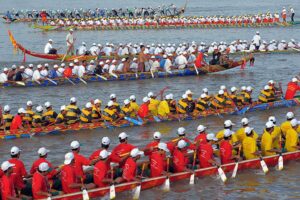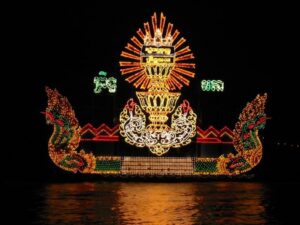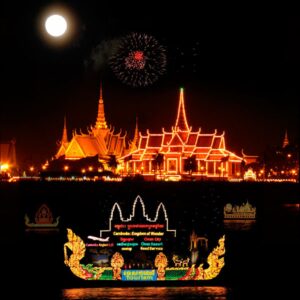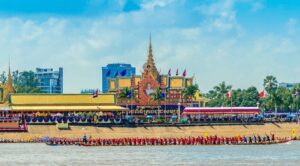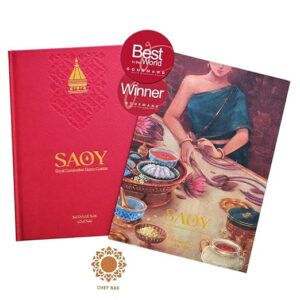The kingdom of Cambodia has a wealth of traditional and cultural festivals dated according to the Cambodian lunar calendar. All these festival are influenced by the concept of Buddhism, Hinduism, and royal cultures. The festivals, which serves as a source of great joy, merriment and Cambodian’s national colors, play a major role in influencing tourists’ opinions, behaviors, and options. Most of these are a time of replacing the predominantly urban and rural populace.
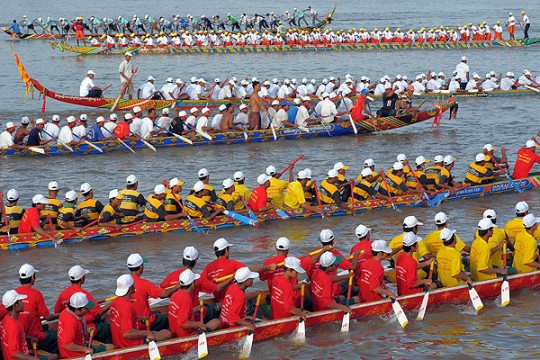
Nowadays the whole nation unites in understanding its cultural values and traditions. Hereafter is some of the important celebrations organized during the year. The Water and Moon Festival, a spectacle to behold, is probably the most exorbitant festival held each year in November. It is usually celebrated for three days, i.e. the 14th and 15th of the waxing moon and the 1st of the waning moon of the month of Kadek. The 15th of the waxing moon is the last full moon day.
History
According to historical records and inscriptions expressed that Jayavarman VII ascended to the throne in the capital of in Yasodharapura and reconstructed the national reconstruction such as the construction of temples, hospitals, roads, and irrigation systems throughout the country. Through the sculpture at Bayon temple, four facades of the four-pronged towers have been found in every corner, making some national and international scholars understand that “Bayon is the legend’s monument of the marvelous legendary”. During the year 1177, the Cham had invaded and controlled Cambodia for about four years. In the meantime, Jayavarman VII united the nation and spent time preparing the army strategy to fight against the Cham until received the victory, and he ascended to the throne of the country in 1181 and made the nation prosper to the highest level. On the walls of the temple, there are carvings related to the people’s lifestyle, customs, traditions, religions, and arts, sports, especially the war with Chams, led by the Jayavarman VII, gained a great success through the naval fighter. What is remarkable is that the navy battle, which is very beautiful and impressive carved on the wall. The naval carving was remembered by the younger Khmer generations on the attributing of ancient ancestors, which liberated the territories from the control of the enemy and held this year’s annual commemorative ceremony. The Festival has been held since the age of Angkor, and Cambodian people always hold the Festival along with all kind of boat racing, both men, and women from all over the country.
Location
The festival ushers in the fishing season, the water of the Mekong River forces the Tonlé Sap and the ebbing-water season and is seen as thanksgiving to the Mekong River for the country with fertile land and abundant fish. At the height of the rainy season, the water of the Mekong river forces the Tonle Sap to reverse its currents and to flow up to the Tonle Sap Lake. As the water of the Mekong River begins to subside, the swollen Tonle Sap Lake flows back to the Mekong River through the Tonle Sap and empties into the sea, which leaves behind vast quantities of fish. This, indeed, is a remarkable phenomenon of the Tonle Sap.
Celebration
The festival has received popular support from all over the country and celebrated annually with the female/male racing boats (Tuk Om and Tuk Jev) and Bandaet Pratit (beginning around 7 pm with illuminated boat takings to the water and each boat represents a government ministry or state institution) for three-day. While the second day of the festival, there are Sam Peah Preah Khae (the Salutation to the Moon) and Ak Ambok (offering banana and Am Bok) ceremony which is performed by Khmer people to commemorate the Bodhisattvas, who took birth as a rabbit and scarifying life to Brahmin.
At the ceremony, the boat racing is held within three days of the festival which starts from 11 am till 5:30 pm. Following by the Illuminated floating boat parade (Bandet Protit) for dedicated to the God of River and God of Earth that joyfulness and fruitfulness in daily-life farming. At night, each ministry is floating its illumination boat (Bandet Protit) and firing the fireworks.
In the 15th of the waxing moon of the month (Midnight of the second day), there is a ceremony in which salutations are made to the moon called Sampeah Preah Khae. Every Khmer family throughout the nation have to celebrate with preparing a table with offerings of fruits (such as Bananas, Coconuts, and other tropical fruits), traditional Khmer rice cake, and flowers.
After the Sampeah Preah Khae ceremony, people gather at a pagoda at midnight for Ak Ambok, and reflecting the strong religious convictions. Ak Ambok is named after the rice dish which forms part if the Bon Om Tuk ceremony. Rice is fried in the husk and then pounded with the giant pestle. The husks are removed and the special rice mixed with coconut and banana. This traditional Khmer dish is sold throughout the festival.
During this occasion, other provinces and cities around the Kingdom also celebrated this festival as well, for instance, Siem Reap, Battambang, Pursat, and others.
Specific Programs (Only in Phnom Penh):
Day 1:
10:00 AM-11: 00 AM Gathering of racing boats
11:00 AM-05: 30 PM Boat racing
03:00 PM-04: 30 PM Distinguished guests including ministers, the prime minister, and last but not least his majesty the king of Cambodia arrives.
06:30 PM
- His Majesty give the royal candle on the Illuminated floating boats of the Royal Palace (which is the leading of the parade) while Pin Peat (Khmer traditional music is played)
- Then, the rest of the Illuminated boats (around 15 boats) from other ministries and state organizations fire up and parade along the river
- The fireworks are set off as soon as the first boat leaves.
- All the floating boats parade along the Tonle Sap river from South to North until 10:00 PM and Stop in front of the Royal Palace.
- At nights, there are art performances for the public under preparation of ministry of fine arts and also some music concerts set up at public parks.
Day 2:
The whole day event is the same as the first day. Midnight of the second day, the full moon, there is a tradition called Sam Peah Preah Khae (the Salutation to the Moon) and Ak Ambok (offering banana and Am Bok) ceremony which is performed by Khmer family to commemorate the Bodhisattvas, who took birth as a rabbit and scarifying life to Brahmin. Even in the Royal Palace also celebrate. This tradition is celebrated only on the second day of the festival.
Day 3:
The third day is the final day of the festival. In addition to the same agenda as the first and second day, there are several traditional events to celebrate the victories highly presided over by his majesty of the kingdom.

